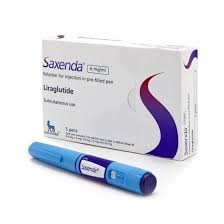BODY SLIMMING PRODUCT
Saxenda (liraglutide) subcutaneous injection is an FDA-approved, prescription injectable medicine that, has an excellent safety profile if used accordingly. When used with a low-calorie meal plan and increased physical activity, it may help some adults with excess weight, namely adults:
– who also have weight-related medical problems (such as high blood pressure, high cholesterol, or type 2 diabetes)
– obesity
– to lose weight and keep it off
Saxenda is drug that mimics an intestinal hormone that tells the brain your stomach is full. It is approved for long-term use by FDA.
Saxenda is not for the treatment of type 2 diabetes and should not be used with any other GLP-1 receptor agonist or insulin. It is not known if Saxenda is safe and effective when taken with other prescription, over-the-counter, or herbal weight-loss products. However, it is advisable to discuss with our trained aesthetic physician regarding any other drugs or supplements should it interact with the efficacy of Saxenda.
Saxenda is prefilled pen injectable and the doses would be increased over a course of 4 weeks until it reaches a maintenance dose on week 5. It should be used with a reduced-calorie meal plan and increased physical activity for best results. This schedule is designed to minimise potential gastrointestinal symptoms such as nausea, diarrhea, constipation, vomiting, low blood sugar (hypoglycemia), decreased appetite, upset stomach, tiredness, dizziness, stomach pain, and changes in enzyme (lipase) levels in your blood.

Frequently Asked Question
How do I use Saxenda?
Saxenda is prefilled pen injectable and the doses would be increased over a course of 4 weeks until it reaches a maintenance dose on week 5.The dose adjustment would be discussed with you by our trained aesthetic physician and may differ from one individual to another depending on their gastrointestinal tolerability.
How should I use Saxenda?
Saxenda (liraglutide) subcutaneous injection can be given straight in at a 90 degree angle or at a 45 degree angle using the ‘pinch’ technique onto the abdominal area, upper leg (thigh), or upper arm area.
Is it painful?
Saxenda is administered via NovoFine needle, fine subcentimeter gauged needle that hardly causes any pain.
Am I a candidate for Saxenda?
Adults with excess weight who also have weight-related medical problems (such as high blood pressure, high cholesterol, or type 2 diabetes), obesity (BMI > 27kg/m2) and anyone who wishes to lose weight and keep it off.
Who should not take Saxenda ?
Saxenda is not recommended for use in children
Saxenda may not be a treatment of choice for those with or family history of MTC, MEN 2 (tumors in more than one gland in their body), or with allergy to liraglutide or any of the ingredients in Saxenda.
Talk with our doctors if you are not sure if you are pregnant, planning to become pregnant breastfeeding or plan to breastfeed. Saxenda may harm your unborn baby.
Saxenda slows stomach emptying and can affect medicines that need to pass through the stomach quickly. Saxenda may affect the way some medicines work and some other medicines may affect the way Saxenda works especially diabetes medicines, especially sulfonylurea medicines or insulin.
Schedule a free consultation with our trained aesthetic physicians today to discuss if you are a suitable candidate for Saxenda.
What are the side effects of Saxenda?
Saxenda can cause some serious side effects if used injudiciously:
-Hepatobiliary problems (pancreatitis, gallbladder problems)
-Low blood sugar (hypoglycemia) in people with type 2 diabetes who also take medicines to treat type 2 diabetes
-Increased heart rate
-Kidney problems (kidney failure)
-Serious allergic reactions
-Depression or thoughts of suicide
-Common side effects of Saxenda include nausea, diarrhea, constipation, headache, vomiting, low blood sugar (hypoglycemia), decreased appetite, upset stomach, tiredness, dizziness, stomach pain, and changes in enzyme (lipase) levels in your blood.











